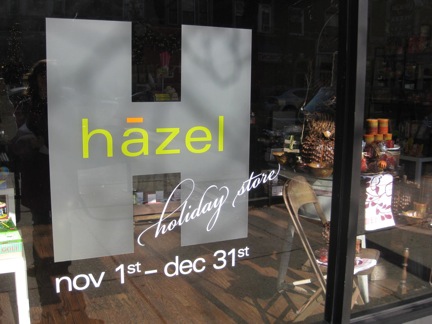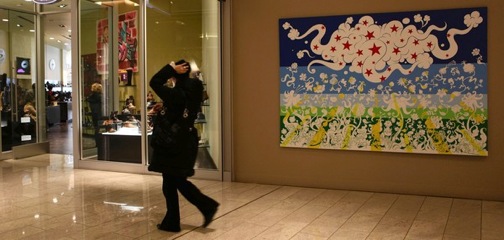Creative Solutions for Dormant Space (original) (raw)
Feature Thu Nov 18 2010
This article was submitted by Amber Gibson.

Photo by Amber Gibson
Sparkling Christmas tree ornaments, nativity characters, sock monkeys and fake vomit have popped up on Montrose Avenue at Hazel Holiday Store.
The pop-up shop is owner David Vail's spin-off of Hazel, a charming Ravenswood gift shop. Offering seasonal décor and children's toys, the holiday pop-up opened Nov. 1 just a few doors west of the original boutique. Vail is getting ready to open a fashion boutique next spring and thought a pop-up, the catchy name for a short-term sales space, was a great way to make use of otherwise unused space.
"We're not trying to bring people in from the Gold Coast," Vail told me. "It's more for our existing customers." Hazel can get crowded during the holiday shopping season, so the additional space makes the store more comfortable.
Temporary space makes sense not only for seasonal retail, but also for artists, fashion designers and restaurateurs to market themselves and reach new audiences. The pop-up idea is not new -- artisans have long embraced the low-overhead and mobility of festivals and markets -- but pop-ups in Chicago have morphed into more individualized and substantive forms. After Target popped-up in Chicago with its Bullseye Bazaar in 2009, with behemoths like Carson Pirie Scott and Calvin Klein following suit, independent businesses are trying it out for themselves.
Alberto Cusi, professor of International Marketing at Northwestern University, told me that pop-ups have two distinct marketing objectives: selling and promotion. For corporations like Target, the focus is squarely on promotion, to check consumer reactions to new products and generate a buzz. "It's a sort of laboratory," Cusi said. "If you're a small company it's a less expensive way to be printed in the local newspaper or magazine."
The best-known and best-funded pop-up art gallery event, Art Loop Open, featured hundreds of artists this fall, displaying their work at prominent venues in the Loop like Macy's, Merchandise Mart, Palmer House and the Chicago French Market. The public voted for their favorite pieces to determine the winner. Grand prize winner John Dempsey won $25,000 for his painting, "The Great American Landscape," and debuts his own pop-up art window at 22 S. Wabash Ave. next week. Dempsey described his forthcoming window as "poppy" and kid-friendly and he hopes to get children involved with his Billy Tokyo anime art, a product of Dempsey's colorful cartoon alter ego.

Dempsey's "The Great American Landscape." Photo by Abel Uribe, courtesy of the Chicago Tribune
"I don't think there are any disadvantages," Dempsey told me about pop-ups. "I don't know why an artist wouldn't do it." Like other Pop-Up Art Loop participants, he embraces the idea of beautifying the city while showing off his artwork.
As long as storefronts remain vacant, the Pop-Up Art Loop will continue, said Michael Perry, programming project coordinator at the Chicago Loop Alliance.

CFI's pop-up. Photo courtesy of Chicago Fashion Resource
What the Pop-Up Art Loop does for artists, the Chicago Fashion Incubator does for local fashion designers. CFI sponsored a month-long pop-up fashion boutique for its designers at 900 Shops at N. Michigan Avenue last spring. Clothes from current participants and alumni were on display, and the prime shopping location allowed designers to reach their ideal demographic. I spoke to several designers and marketers last week, who explained why they adopted a pop-up strategy.
"Marketing and exposure were really my main goals, both for the Incubator and for our designers," said Lara Miller, CFI's executive director. Miller said the event was a huge success and looks forward to putting on another pop-up at the 900 Shops in 2011.
Evil Kitty designer Lidia Wachowska, a 2008 CFI alum, said the fee for designers was minimal and the exposure and sales were more than worth it.
"Since 900 Shops is such a prestigious brand, I had the opportunity to sell my more expensive pieces," Wachowska said. "I would never get access to those customers without a shop on the Magnificent Mile."
Current Incubator designer Christina Fan sold her basics line at the 900 Shops pop-up. She was really pleased with the publicity and reception her line received, but generally prefers trunk shows to pop-up shops, because she thinks they are less risky and designers can utilize an already existing customer base.
"For pop-up shops it's a lot more work," Fan said. "There's overhead involved in terms of rent and having staff available and you need to work really hard to drive consumers into the store too."
Miller advised anyone thinking of pursuing their own pop-up endeavor to carefully consider the location in relation to their target market, and said finding a landlord interested in a temporary lease is key.
Jackie Lumzy, head of publicity at 7th Market Agency, agreed that finding a space can be the most difficult part of the process, since landlords can be hesitant to rent spaces for just a few days. Lumzy coordinated a fashion pop-up in Wicker Park for a weekend in October to celebrate the first anniversary of the creative lounge CHICAGO. She said that pop-ups create a sense of urgency for the customer.
"Get it now or you're never going to get it," Lumzy explained. Lumzy likened pop-up shops to websites like Gilt Groupe and Rue La La that host invitation-only sample sales. However, pop-ups allow customers to feel the material and try clothes on, giving them an advantage over online competitors.
"I think it works across any industry," Lumzy said. Furniture designer Sean Scott of S2 Design provided all of the furniture for the creative lounge pop-up, and although the exposure has yet to translate into any sales, he said it was a wonderful opportunity and great use of otherwise unoccupied space in the neighborhood.
"I think part of what makes the pop-up shop successful is the decline of the real estate industry," Scott said. "It's a great way to use these spaces that may not be used in various neighborhoods."
Lumzy said the buzz and spontaneity of pop-up shops is akin to the chaos and excitement behind the food truck movement. "We're thinking of having a mobile pop-up shop, like cupcake trucks," she said. "We'll have our designers in an RV and be able to travel not only in Chicago but across the country."
However, Jason Hammel, owner and chef at Lula and Nightwood, said that pop-up restaurants and food trucks are more different than alike. "Pop-ups are less viable," Hammel told me. "It's not like you could make a lot of money by having a pop-up restaurant. Typically you lose money. You're doing it for the buzz."
Hammel participated in a joint pop-up restaurant with Urban Belly's Bill Kim for a weekend this summer at Logan Square Kitchen. Lula Cafe also dons a costume each Halloween, transforming into a different restaurant, complete with new menus, uniforms and decorations. Lula has masqueraded as Olive Garden and Hot Doug's in years past, and this year the cafe dressed up as Kuma's Corner, calling itself "Luma's Corner." Although the Halloween event isn't technically a pop-up, since it takes place in the regular restaurant space, an immense amount of time and effort goes into planning the one-night event.
"We had a line going down the block this year, and a three hour wait," Hammel said. "It's good for staff morale and it creates a buzz." For Hammel, the fun justifies continuing the annual Halloween tradition, even if it's not a moneymaker.
Pop-up shops allow for experimentation and their fleeting and unpredictable nature mirrors the shortened careers and job-hopping that many workers increasingly contend with. Many see pop-ups continuing indefinitely.
"It seems like there is more online shopping and less people committing to long-term rent," Miller said. "Pop-up shops are definitely not a fad but something that will stick around."
It remains to be seen whether consumers grow weary of gimmicky pop-ups, or whether pop-ups continue evolving to stay one step ahead of the competition.
"When you have a regular shop, you can only have a grand opening once," Wachowska said. "But with a pop-up, it's newsworthy every time you do it."
~*~
This feature is supported in part by a Community News Matters grant from The Chicago Community Trust and the John S. and James L. Knight Foundation. More information here.
